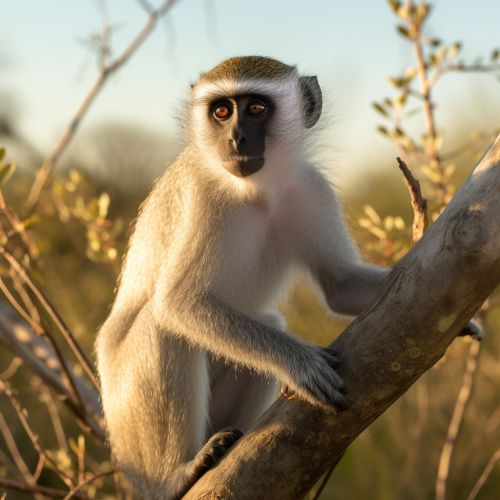Chlorocebus pygerythrus
Taxonomy and Phylogeny
The Chlorocebus pygerythrus, commonly known as the Vervet Monkey, is a primate species that belongs to the family Cercopithecidae, also known as the Old World monkeys. This family is one of the two major divisions of the simian primates, the other being the New World monkeys. The Cercopithecidae family is further divided into two subfamilies: the Cercopithecinae, to which the Vervet Monkey belongs, and the Colobinae.


The genus Chlorocebus, which the Vervet Monkey is a part of, includes several closely related monkey species that are distributed across sub-Saharan Africa. These species were previously classified under the genus Cercopithecus, but were later reclassified due to significant differences in their morphology and behavior.
Description
The Vervet Monkey is medium-sized, with a body length ranging from 40 to 60 cm, not including the tail, which can be up to 1 meter long. Males are generally larger than females, with an average weight of 5.5 kg compared to 4 kg for females. The species is characterized by its black face and hands, contrasted by a grey body hair color. The monkeys also have a distinctive white fringe of hair running along the eyebrows and the cheeks.
One of the most notable features of the Vervet Monkey is its bright blue scrotum, which is thought to be a form of sexual signaling. This is an example of sexual selection, a concept first proposed by Charles Darwin to explain the evolution of traits that do not directly contribute to survival, but enhance reproductive success.
Distribution and Habitat
Vervet Monkeys are widely distributed across sub-Saharan Africa. Their range extends from Ethiopia and Somalia in the east, to Senegal in the west, and southwards to the Cape of Good Hope in South Africa. They inhabit a variety of environments, including savannas, woodlands, and mountainous areas up to 4000 meters above sea level. They are also known to adapt to living in areas disturbed by humans, and can often be found in rural and urban environments.
Behavior and Ecology
Vervet Monkeys are diurnal, meaning they are active during the day and sleep at night. They live in social groups, known as troops, which typically consist of 10 to 50 individuals. These troops are multi-male, multi-female groups, with a strict dominance hierarchy among both males and females. The dominant males have priority access to food and mates, but their position is constantly challenged by other males.
The diet of the Vervet Monkey is omnivorous, consisting of a variety of fruits, leaves, seeds, flowers, insects, and small vertebrates. They have also been known to eat crops, which can lead to conflict with farmers.
Reproduction
The mating system of the Vervet Monkey is polygynandrous, meaning both males and females have multiple mating partners. Females give birth to a single offspring after a gestation period of about 165 days. The young are cared for primarily by the mother, but other females in the troop may also assist in their care, a behavior known as alloparenting.
Conservation Status
The Vervet Monkey is currently listed as Least Concern on the IUCN Red List due to its wide distribution and large population. However, the species faces threats from habitat loss and hunting. In some areas, they are killed for crop raiding, while in others they are hunted for bushmeat.
